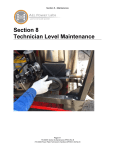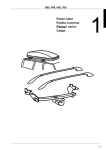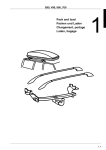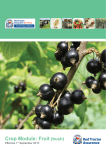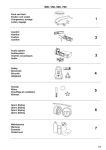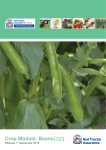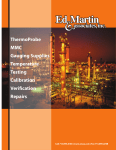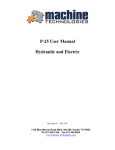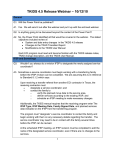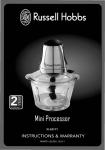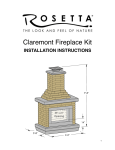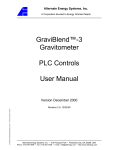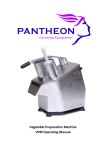Download ASP Manual - Sustainable Agriculture Research and Education
Transcript
Prepared by Adam Schwartz; Symbiosis Design Build LLC January 2014 On-Farm ASP Composting ! User Manual for Small-Scale Aerated Static Pile Composting Project Funded By: Sustainable Agriculture Research and Education (www.sare.org) Prepared by Adam Schwartz; Symbiosis Design Build LLC ! January 2014 Aerated Static Pile (ASP) System Compost systems using forced aeration or “Aerated Static Pile” (ASP) are in use throughout the commercial composting industry. The technology for these systems are simple and proven effective but have not been broadly adopted by the farming and agriculture sector. The goal of this report is to share our research in small scale ASP systems adapted for farms looking to increase their production of compost for on-farm use while handling the many organic wastes that the farm may handle in a given year. ASP compost works by increasing oxygen levels in the compost pile, maintaining temperatures at optimal levels and increasing the decomposition rate dramatically. This results in a more consistent compost product, reduced odors and less labor required. In this manual we will go over the elements of a system, the process flow of operating one, as well as some common recipes, troubleshooting and more. Comparison to Passively Aerated Windrows For the purposes of this project we compared effectiveness of ASP compost systems to that of Passively Aerated Windrows. Windrows are a common form of composting, using a linear pile with a windrow cover to maintain moisture. By adding perforated pipes every foot along the pile we allow for air to passively enter the pile via the heat stack effect. This innovation on the traditional compost windrow is a more low-tech option to the forced air ASP system but still provides some of the benefits of increased oxygen levels and is ideal for small-farm operations on a budget. Project Funded By: Sustainable Agriculture Research and Education (www.sare.org) Prepared by Adam Schwartz; Symbiosis Design Build LLC January 2014 Advantages of “forced air” Compost ‣ Faster and more consistent compost quality ‣ Less labor intensive ‣ Reduce odors ‣ Eliminate pathogens and weed seeds ‣ Reduce stormwater runoff ‣ Improve value of your farm business ‣ Simple to use technology ‣ Produce high quality compost for your gardens or pasture! Basic Elements to an ASP Compost System 1. Pressure Blowers: similar to those used for moon bounces; ranging from 1/3hp to 1hp depending on system size, and should be placed in an area protected from the elements. 2. On/Off Timer: When you manually turn a compost pile the newly available oxygen is used up in a manner of minutes. We set our timer to run for 10 minutes every hour, this does the “work equivalent” of turning a compost pile 24 times a day for the duration of the process! 3. Temperature Probe: Every composter needs a good reliable soil thermometer capable of reaching high temps. Your ASP system should reach optimal temperatures in the first 4 to 5 days and maintain a temp of between 130 and 155 degrees Farenheit for the duration of the active compost process. 4. Zone dampers: Depending on how many compost bays you want to compost in you will want to be able to turn off and on different bays for when they are loaded with a compost recipe or for when they are being emptied. Project Funded By: Sustainable Agriculture Research and Education (www.sare.org) Prepared by Adam Schwartz; Symbiosis Design Build LLC January 2014 5. Leachate Trap: When composting food waste, the intracellular water in the food will drop out as it reaches temperature. It is important to capture this water to protect it from polluting the environment. A pond liner with bulkhead fitting that drains to a tank or vessel for later pile re-wetting is an acceptable solution. 6. Perforated Pipe: The most effective method for distributing forced air into a pile is through a few perforated PVC pipes along the bottom of the pile. Take care to drill holes along the bottom portion of the pile to prevent from clogging and cover them with 4 to 6 inches of dry wood chips to further prevent clogging and maximize airflow. ! Image from “On Farm Compost Handbook” by Robert Rynk ! ! Project Funded By: Sustainable Agriculture Research and Education (www.sare.org) Prepared by Adam Schwartz; Symbiosis Design Build LLC January 2014 Process/Flow & Methodology Feedstock Preparation: Forced Aeration systems typically require a lower Bulk Density than traditional windrow composting. This is because the air needs to infiltrate the pile without overburdening the pressure blower. Typically the easiest way to lower bulk density is to add wood chips, which create more air cavities within the pile and do not quickly compact like leaves do, requiring manual pile turning. Here are some examples of feedstock C:N contents. * Carbon: dry leaves (47:1), wood chips (220:1), hay/straw (53:1) * Nitrogen: food waste (15:1), animal manures (10:1), grass clippings (15:1) You want a 30:1 ratio of Carbon to Nitrogen C:N. There are various charts and calculators available on the internet but you will need to to get a rough estimate of the bioavailability of nutrients in your feedstocks and calculate for % by net weight. Mixing and Pile Recipe: The more pre-broken down your materials are, the better availability of nutrients for the microbes in the pile and the higher quality and consistency of your final product. We used a chipper/shredder to breakdown food waste, woody weeds and brush easily and quickly when loading an aeration bay. These chipper shredders are commonly found at any hardware store and are a highly recommended tool in your ASP compost setup. After breaking down your feedstocks, mix thoroughly and evenly as possible, watering throughout as you load the bay. It is a common mistake to layer feedstocks in a “lasagna” style, but this will only produce poor consistency compost and pockets of anaerobic (smelly & unfinished) compost. * Compost Plenum: The Plenum, or “bulking agent” is a layer of brush or wood chips at the bottom of an ASP pile. It is a key part of composting with aeration as it allows for even distribution of the air throughout the pile. Load enough wood chips in your bay to cover your pipes before loading in your compost mix. * Compost Cap: The compost cap is simply a 4-6” layer of finished compost on top of your pile. Since you will not be turning the pile and air will be flowing through it, the cap serves to filter odors and maintain moisture and temperature on the inside of the pile. A compost cap can be used instead of a cover in the case of ASP systems , particularly when a roof is is keeping rainwater runoff away, because a compost cap breathes better than a cover. Project Funded By: Sustainable Agriculture Research and Education (www.sare.org) Prepared by Adam Schwartz; Symbiosis Design Build LLC January 2014 Pile Management: Aeration on your compost pile will increase microbial activity and heat up your pile quickly. Ideal pile temperatures should be between 135 and 150 degrees F. Temperatures above 160 can be bad for microbial activity. The increased aeration will dry out your pile faster than a regular compost pile, so it is important to check moisture regularly and add water as necessary. Investing in a decent temperature probe is a necessary tool, ReoTemp makes a good, long stem compost thermometer. Make sure to take temperature readings from several parts of the pile to get a good overall idea of how the pile is doing. Irregularities could be due to a blockage in air flow, anaerobic (smelly) pockets or lack of adequate moisture throughout the pile. You should run your aeration system on a timer for 10 minutes every hour for at least 4 weeks although 6 weeks would be ideal. At the end of this cycle it is a good idea to dry your compost out to prepare for screening. A dry compost will screen better without clumping, we recommend running your ASP system for several days without watering to help dry it out, if you have a compost cover, uncover the pile to help facilitate the drying process. Screening: As your pile decomposes, it compresses and can become clumpy, you also may have particles of un-composted woody debris in your pile, this is okay. Screening your finished compost is a critical part of getting a consistent, quality product to use on your plants. You want to screen to at least 3/8” particle size. There are plenty of DIY screeners out there, we went with this small, motorized “trommel” style screener, found at drpower.com This little machine turns a task that typically takes two people an hour, into a one person job in 10-15 minutes. It mounts above a wheelbarrow and makes easy work of emptying your compost bay. Curing: A finished “mature” compost means that the active “thermophilic” composting is complete and the compost is stable, meaning that its nutrients are not water soluble, but are plant available. Typically after screening there will be an initial temperature spike from the increased aeration. It is important to create windrows of your almost finished compost for curing and cooling off before using on your farm or garden. Do make sure to re-wet your curing piles and continue to monitor temperatures. After another 2 to 4 weeks they should be ready for use. If storing compost for long periods of time it is ideal to keep in an outdoor covered area or store under a tarp or other compost cover. Project Funded By: Sustainable Agriculture Research and Education (www.sare.org) Prepared by Adam Schwartz; Symbiosis Design Build LLC January 2014 Glossary of Terms ‣ Pile Porosity: The amount of air filled pore space in a compost pile that is not occupied by solid particles or water. Porosity is expressed as a percentage of the total bulk volume of the compost pile. An adequate supply of oxygen is needed for microbial respiration in aerobic decomposition. Proper Free Air Space (FAS) should be between 30-60% of total volume for ideal aeration. ‣ Bulk Density: The ratio of the total weight (mass) of the compost to its volume. Common units of measure of pounds per cubit yard (lb/yd). Bulk density of feedstocks are important to convert recipies from weight to a volume basis for field mixing. The amount of moisture in compost strongly affects bulk density. ‣ Volatile Organic Compounds (VOC’s): Organic compounds naturally occurring as organic waste breaks down that easily become vapors or gasses. VOC’s are typically produced in the first few days of the active composting process and can contribute to pile odors. Best management practices such as proper aeration, biofilters and compost caps & covers can greatly reduce VOC emissions from compost. ‣ Processing for Further Reduction of Pathogens (PFRP): PFRP is an industry standard for time and temperature requirements when composting animal manures or food waste to reduce pathogens and vectors. For Aerated Static Pile (ASP) to reach PFRP, it must typically reach a minimum pile temperature of 130 degrees Fahrenheit for at least 3 continuous days during its cycle. ‣ Compost maturity: After thermophilic decomposition and curing, a mature compost shows signs of slowed down activity, reduced temperatures, a rich uniform texture and color, earthy smell. Mature compost has a nutrient content that is plant available but not water soluble and therefore will not burn plants when applied directly to soil. Other Resources: ‣ O2Compost Systems: www.o2compost.com ‣ Online Compost Calculator: http://www.organicsciencesllc.com/composting.htm ‣ On Farm Compost Handbook, by Robert Rynk. (1992) Project Funded By: Sustainable Agriculture Research and Education (www.sare.org)








